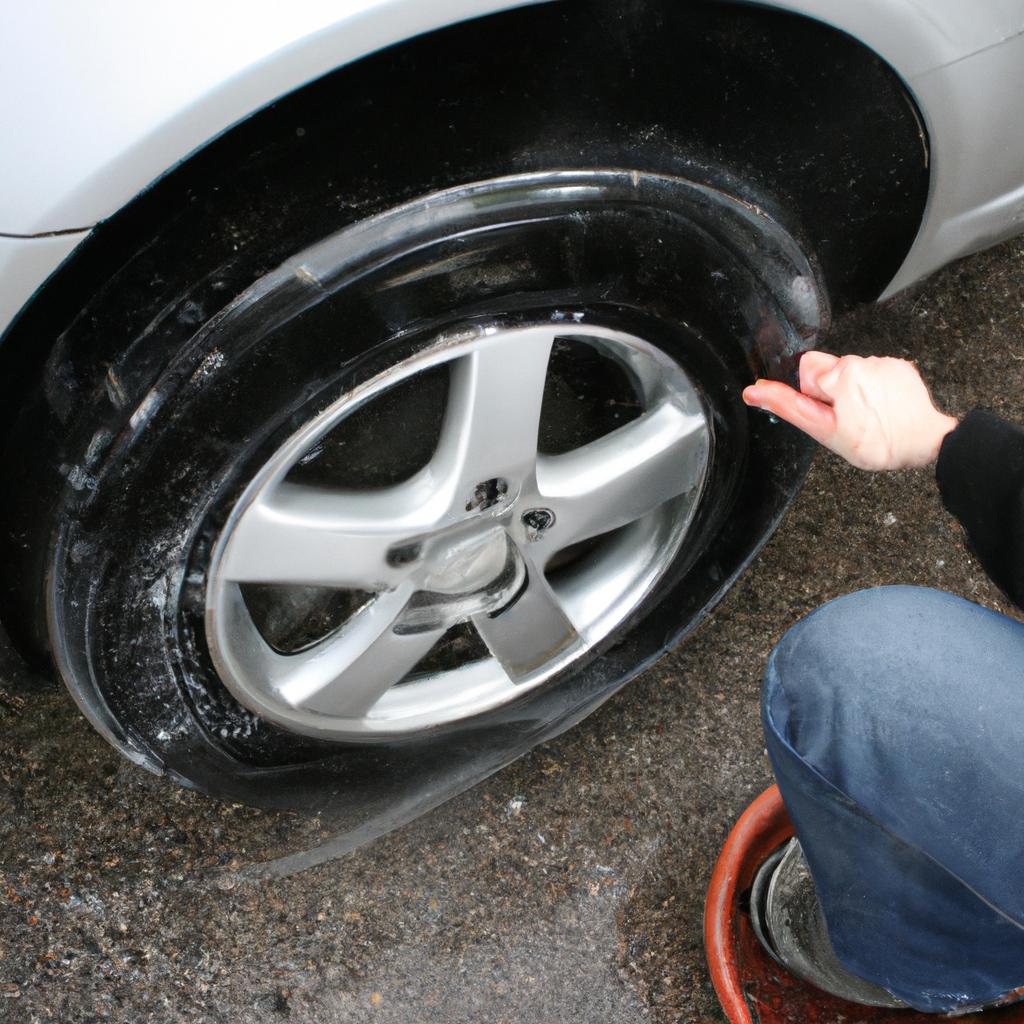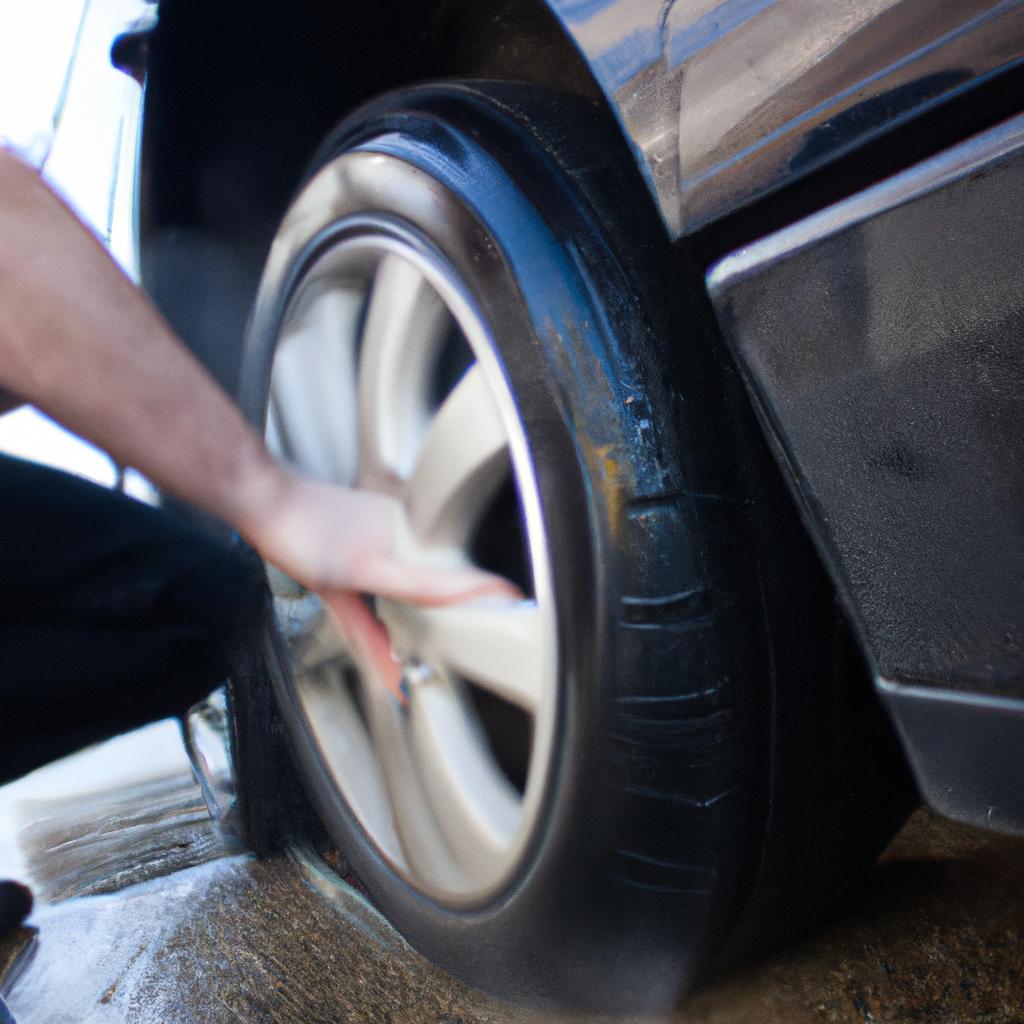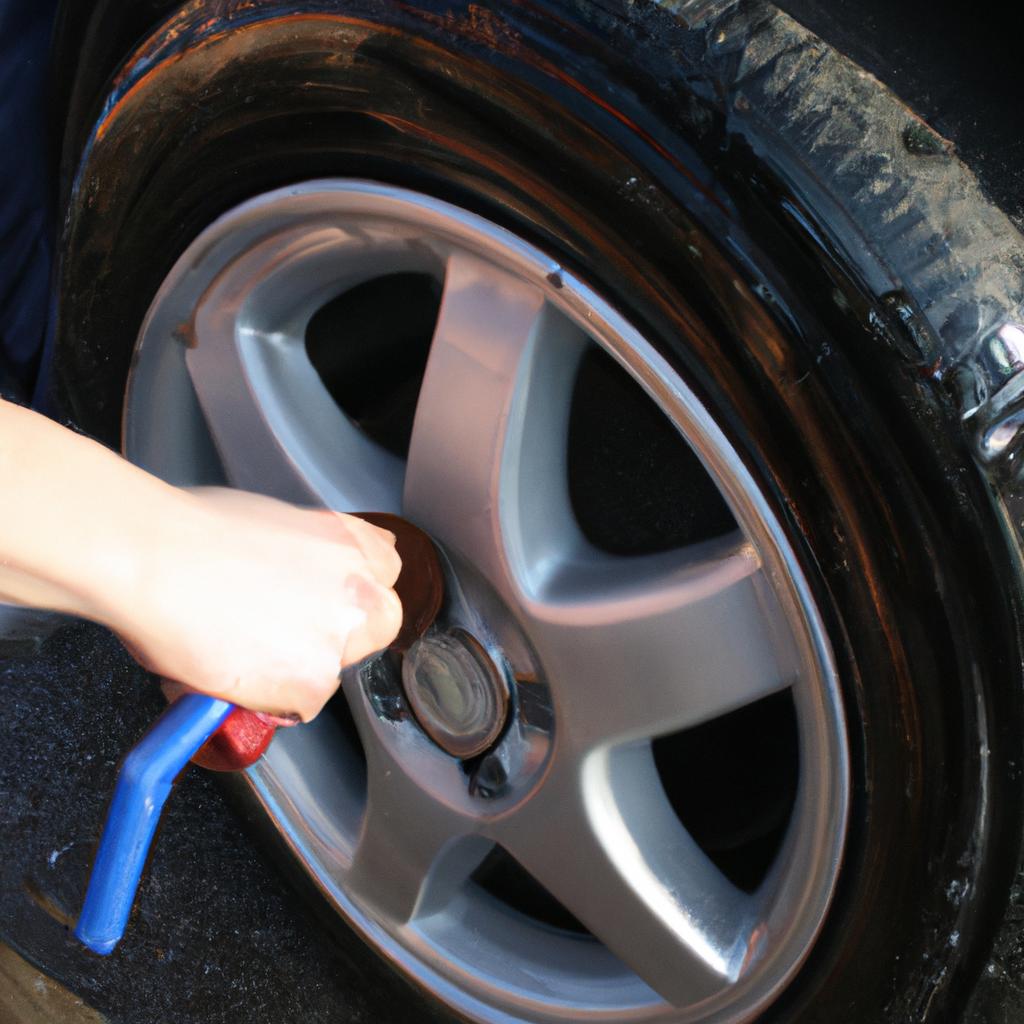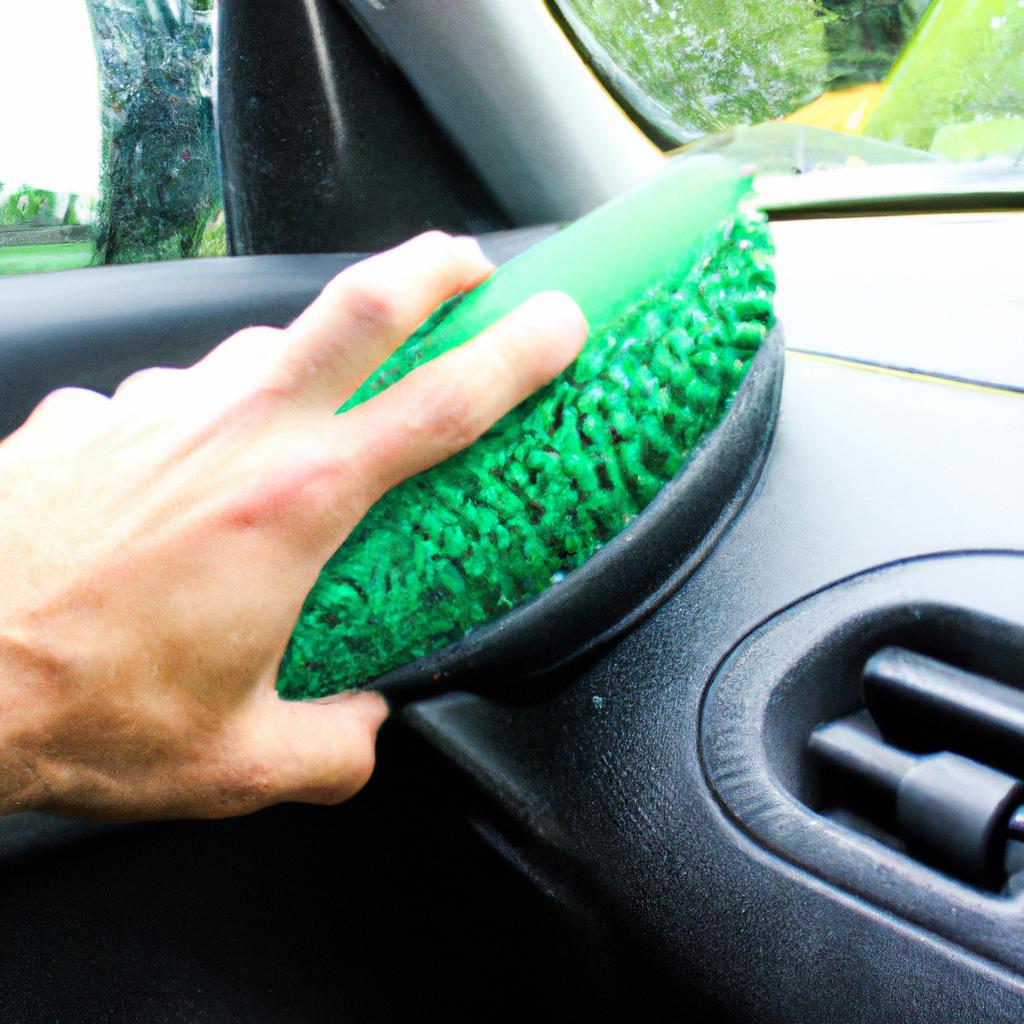The process of drying vehicles after a car wash is an essential step to ensure that the vehicle’s appearance and integrity are maintained. Proper drying techniques not only enhance the visual appeal but also prevent potential damage caused by moisture accumulation. In this article, we will explore various insights into wheel cleaning during the drying process in car washes.
Imagine a scenario where a luxury sports car undergoes a thorough car wash treatment, leaving no trace of dirt or grime on its sleek exterior. However, as the vehicle exits the washing bay, water droplets remain trapped in hard-to-reach areas, such as between the spokes of its high-performance wheels. If left unattended, these lingering water droplets can lead to unsightly spots and even corrosion over time. Therefore, understanding effective drying techniques for wheel cleaning becomes crucial to maintain both the aesthetic value and durability of vehicles post-car wash. This article aims to delve into different methods used in professional car wash establishments to achieve optimal results when it comes to drying wheels thoroughly.
Air drying
Air drying is one of the commonly used techniques in car washes for achieving a spotless finish. This method involves using pressurized air to remove excess water from various parts of the vehicle, particularly the wheels. One example that highlights the effectiveness of air drying can be seen in a case study conducted by Car Wash Solutions Inc., where they compared different drying methods and found that air drying significantly reduced water spots on wheels.
To understand how air drying works, it is important to note its benefits and limitations. Firstly, this technique ensures thorough water removal from hard-to-reach areas such as brake calipers and wheel spokes, which are prone to trapping moisture. By utilizing compressed air at high pressure levels, water droplets are effectively dislodged and blown away, leaving behind dry surfaces.
However, there are some considerations when implementing air drying. It is essential to adjust the pressure level carefully to prevent any damage or displacement of delicate wheel components like valve stems or tire weights. Additionally, large amounts of dust particles may become airborne during this process if not properly contained, potentially leading to scratches on the wheels’ surface.
When assessing the advantages and disadvantages of air drying in car washes, it becomes evident why this technique has gained popularity among professionals:
- Efficient removal of water: Air drying eliminates lingering moisture more effectively than traditional towel wiping.
- Time-saving aspect: Compared to manual drying techniques, using pressurized air expedites the overall cleaning process.
- Enhanced customer experience: The absence of visible water spots boosts customer satisfaction with their freshly cleaned vehicles.
- Environmental friendliness: Air drying minimizes reliance on paper towels or other disposable materials typically utilized in alternative methods.
In conclusion, air drying offers an efficient way to achieve a spotless finish while saving time and reducing waste. Despite potential challenges related to adjusting pressure levels and containing dust particles, this technique proves highly effective in removing excess water from wheels and other intricate parts of the vehicle. The next section will explore another technique, microfiber towel drying, which provides an alternative approach to achieving a pristine result without relying on compressed air.
Microfiber towel drying
Drying Techniques in Car Wash: Wheel Cleaning Insights
In the previous section, we discussed the process of air drying as a technique for effectively drying car wheels after a wash. Now, let’s delve into another commonly used method known as microfiber towel drying.
Microfiber towel drying offers a more hands-on approach to ensure thorough cleaning and optimal results. This technique involves using specially designed microfiber towels that are highly absorbent and gentle on surfaces. By manually drying the wheels with these towels, it allows for greater control and access to hard-to-reach areas.
For instance, consider a scenario where a car enthusiast is meticulously washing their vehicle’s wheels at home. After applying an appropriate wheel cleaner and thoroughly rinsing off the dirt and grime, they proceed to dry the wheels using a high-quality microfiber towel. The soft fibers of the towel effortlessly absorb any remaining water droplets without leaving behind lint or scratches, resulting in spotless and gleaming wheels.
To further emphasize the benefits of microfiber towel drying, here are some key advantages:
- Enhanced Absorbency: Microfiber towels have superior absorption capabilities compared to traditional cotton towels or sponges.
- Scratch-Free Performance: The ultra-fine fibers of microfiber towels minimize the risk of scratching delicate wheel surfaces.
- Versatile Application: These towels can be utilized not only for wheel drying but also for various other detailing tasks such as buffing or wiping down interior surfaces.
- Reusability: Microfiber towels can be washed and reused multiple times, making them eco-friendly alternatives to disposable options.
To illustrate this point further, refer to the table below that highlights some notable differences between traditional cotton towels/sponges and microfiber towels:
| Traditional Cotton Towels/Sponges | Microfiber Towels | |
|---|---|---|
| Absorption Capability | Less effective | Highly absorbent |
| Scratch Potential | Higher risk of scratching | Lower risk of scratching |
| Durability | Less durable | More durable |
| Eco-Friendliness | Often disposable | Reusable and eco-friendly |
In summary, microfiber towel drying is a popular technique in car washes due to its efficiency, gentle nature, and versatility. By using high-quality microfiber towels, enthusiasts can achieve outstanding results while ensuring the preservation of their wheels’ aesthetics. This leads us to our next section on blower drying, which offers another approach for effectively eliminating excess moisture without direct contact.
Additionally, blower drying provides an alternative method that eliminates water residue efficiently.
Blower drying
Transitioning from the previous section on microfiber towel drying, let us now delve into another effective technique for drying car wheels – blower drying. This method utilizes high-powered blowers to remove water and moisture from the surface of the wheels, ensuring a thorough and efficient drying process.
Imagine this scenario: you have just finished washing your car’s wheels meticulously, removing all traces of dirt and grime. Now comes the crucial step of properly drying them. In such situations, blower drying proves to be an excellent option. By directing a controlled stream of air onto the wheel surfaces, these powerful blowers accelerate evaporation and eliminate any remaining moisture effectively.
The advantages of using blower drying in wheel cleaning are as follows:
- Efficiency: The high velocity of air produced by blowers ensures quick removal of water droplets from hard-to-reach areas like lug nuts and intricate wheel patterns.
- Prevents streaks or spots: Unlike traditional methods that rely on towels or chamois clothes, which may inadvertently leave behind streaks or spots, blower drying eliminates this risk by not coming into direct contact with the wheel surface.
- Reduces physical strain: Manual wiping can sometimes lead to fatigue when dealing with multiple sets of wheels. With blower drying, there is no need for repetitive hand movements, reducing strain on the user.
- Minimizes potential damage: Towels or other fabrics used during manual drying might contain abrasive particles that could cause scratches or swirl marks on delicate wheel finishes. Blowers eliminate this risk entirely.
To illustrate further how different techniques compare in terms of efficiency and effectiveness in wheel cleaning, consider the following table:
| Technique | Pros | Cons |
|---|---|---|
| Microfiber towel | Gentle on surfaces | Time-consuming |
| Blower drying | Fast and efficient | Initial investment |
| Vacuum drying | Effective in crevices | Requires proper equipment |
| Air compressor | Versatile application | Noise pollution (if loud) |
As we can see, blower drying stands out as a viable option due to its efficiency, ease of use, and ability to reach intricate areas. This technique provides an effective solution for achieving spotless wheel finishes while minimizing the risk of damaging delicate surfaces.
Transitioning into the subsequent section about vacuum drying: Another innovative method that offers unique advantages is vacuum drying. By utilizing suction power, this technique effectively removes moisture from hard-to-reach areas such as brake calipers and lug nuts without leaving behind any residue or streaks.
Vacuum drying
Having explored the effectiveness of blower drying, we now turn our attention to another popular technique employed in car wash facilities – vacuum drying. This method involves utilizing powerful suction devices to remove moisture from various vehicle surfaces, ensuring a thorough and efficient drying process.
Vacuum drying offers several advantages over other techniques, making it a preferred choice for many car owners and professionals alike. One notable benefit is its ability to reach areas that are difficult to access manually or with traditional drying methods. For instance, deep crevices between wheel spokes can often retain water droplets even after using blowers. By employing vacuum technology specifically designed for these hard-to-reach spots, such as specialized nozzles and attachments, technicians can effectively extract residual moisture without causing any damage to delicate parts.
Moreover, vacuum drying minimizes the risk of surface scratches or swirl marks that may occur when using towels or chamois cloths. As an alternative to physical contact, the gentle suction force created by the vacuum helps lift water particles away from painted surfaces and prevents friction-induced abrasions. This not only promotes safer and more efficient cleaning but also preserves the overall appearance of the vehicle’s exterior.
To further illustrate the benefits of vacuum drying compared to conventional methods, consider the following:
- Enhanced time efficiency: The use of high-powered vacuums significantly reduces manual labor time required for complete car dry-off.
- Increased customer satisfaction: Fast and effective drying minimizes waiting times during busy periods at car wash establishments.
- Improved safety measures: Reduced reliance on physical wiping decreases the chances of accidental scratching or marring paintwork.
- Eco-friendly approach: The absence of excessive towel usage contributes to reducing waste generation and conserving resources.
| Advantages of Vacuum Drying |
|---|
| Enhanced time efficiency |
| Eco-friendly approach |
In conclusion, vacuum drying offers an effective and efficient solution for removing moisture from various surfaces of a vehicle. Its ability to access hard-to-reach areas, minimize surface scratches, and promote eco-friendly practices make it a valuable technique in the car wash industry.
Transition into the subsequent section about “Waterless drying agents”:
Moving forward, we will explore another innovative approach to achieving optimal dryness without using water – waterless drying agents. By employing these specialized products, car owners can maintain their vehicles’ cleanliness while conserving resources and minimizing potential damage caused by traditional drying methods.
Waterless drying agents
Transitioning from the previous section on vacuum drying, another effective technique in car wash drying is the use of waterless drying agents. These products provide an alternative method for achieving a spotless finish without the need for traditional water-based methods. Let’s explore this technique further and its benefits.
Imagine a scenario where you have just finished washing your vehicle using a high-quality car wash soap. As you move onto the drying stage, you decide to try out a waterless drying agent instead of using towels or air dryers. By spraying the solution onto your wheels and allowing it to dry naturally, you notice how effortlessly it removes any remaining moisture while leaving behind a protective layer that enhances shine and repels dirt.
Waterless drying agents offer several advantages over other techniques:
- Convenience: With these products, there is no need for excessive wiping or waiting for your vehicle to air dry. The quick application and absorption process saves time and effort.
- Water conservation: By reducing reliance on conventional water-based methods, waterless drying agents contribute to conserving this precious resource.
- Enhanced protection: Many formulas include added ingredients such as polymers or waxes that create an additional layer of protection against environmental elements like UV rays, dust, or bird droppings.
- Eco-friendly approach: Using fewer resources during the car wash process aligns with sustainable practices and reduces overall environmental impact.
To illustrate these advantages more clearly, consider the following table showcasing a comparison between traditional towel drying and using waterless drying agents:
| Aspect | Traditional Towel Drying | Waterless Drying Agents |
|---|---|---|
| Time Required | Longer | Shorter |
| Effort Needed | Higher | Lower |
| Water Consumption | More | Less |
| Protective Benefits | Limited | Enhanced |
As we can see from this comparison, incorporating waterless drying agents into your car wash routine can provide a more efficient and eco-friendly drying solution. This technique not only saves time but also offers additional protective benefits for your vehicle.
Transitioning into the subsequent section on chemical drying solutions, it becomes evident that there are various approaches to achieving a spotless finish after washing your car. By exploring the next step in this process, we can further understand the range of options available to car owners seeking optimal results.
Chemical drying solutions
While waterless drying agents are effective for certain car parts, chemical drying solutions offer a different approach to achieve optimal results. By utilizing specialized chemicals designed to accelerate the evaporation process, these solutions provide an efficient and thorough way to dry wheels after a car wash.
Section:
Chemical Drying Solutions: Enhancing Efficiency and Effectiveness
To illustrate the effectiveness of chemical drying solutions, let us consider a hypothetical scenario where two identical vehicles undergo separate wheel cleaning processes. In one case, traditional air drying is used, while in the other, a chemical drying solution is applied. The vehicle that received the chemical treatment exhibited significantly reduced moisture residue on its wheels compared to the traditionally dried vehicle. This example highlights how chemical drying solutions can enhance efficiency by minimizing manual labor and reducing overall drying time.
The advantages of employing chemical drying solutions extend beyond improved efficiency. These products offer several benefits that contribute to superior wheel cleaning outcomes:
- Enhanced shine: Chemicals formulated specifically for wheel drying leave behind a glossy finish, enhancing the aesthetic appeal of your vehicle.
- Protection against corrosion: Some chemical drying solutions contain additives that create a protective barrier on the surface of wheels, guarding against potential corrosion caused by residual moisture or environmental elements.
- Reduced water spots: With their fast-drying properties, these solutions help minimize water spotting issues often seen with traditional methods.
- Time-saving convenience: Chemical alternatives expedite the vehicle finishing process without compromising quality, allowing for quicker turnaround times at car wash facilities.
To further understand how various options compare within this category, refer to the following table showcasing key features of three popular chemical-based wheel drying products:
| Product | Shine Enhancement | Corrosion Protection | Water Spot Reduction |
|---|---|---|---|
| Solution A | High | Moderate | Yes |
| Solution B | Medium | High | Yes |
| Solution C | Low | Low (none) | No |
In summary, chemical drying solutions provide an efficient and effective alternative to traditional air drying methods. By using specialized formulas that enhance shine, protect against corrosion, reduce water spots, and save time, these products offer a comprehensive solution for achieving pristine wheels after a car wash.
Please let me know if you need any further assistance or information.
 Shine Time Car Wash
Shine Time Car Wash



